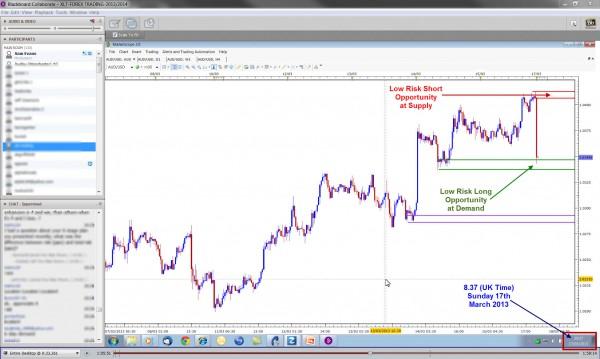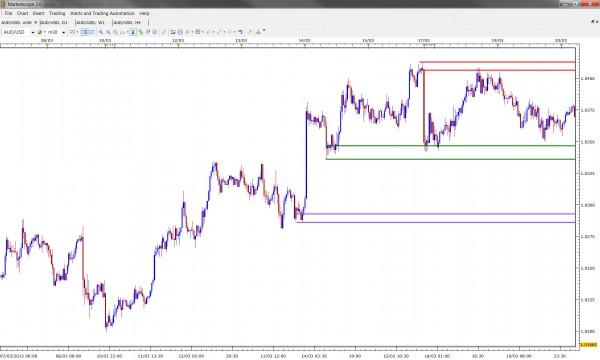Personally, it has been a pretty busy week for me and Online Trading Academy in London, and that’s the way I tend to like it. Sure, I like my downtime like most and when I want to switch off from work I do so, but to me there is nothing better than keeping my mind active and stimulated, and working with students of Online Trading Academy certainly provides that. This week end just passed, I spent 3 days co-teaching a class with Sam Seiden, a good friend and mentor to me from the past. It is always good to team up with Sam as we live in different parts of the world and while we do get to chat frequently, it is not so common for us to teach a class together that often.
During one of the breaks we sat down and were chatting about our own trading and how it does not really take up too much of our time. In fact we discussed how so many people are always asking when we actually get time to trade, considering our commitments to the students and teaching for Online Trading Academy. Well just like so many people look at the financial markets in the wrong way and do the wrong things, they also tend to have the wrong idea of what trading really involves on a day to day basis.
Ninety percent of market speculators in the world today tend to breakeven or worse yet, they lose money on a consistent basis. The main reason why this happens is not because they don’t have a secret indicator or trading robot but mainly because of the mindset. The average trader looks at the markets through the eyes of a retail trader. The major institutions out there today look at the markets through a very different set of eyes altogether and that is what we train our students to do as well. You ask the retail trader what it takes to make money in the markets and they will often say that you need the most cutting edge analysis skills or date feeds to make it work, combined with thousands of hours of “screen-time” at the charts, decoding the secret messages within the candles! Do you really think that the major investment houses and funds sit there each and every day picking candle patterns to make their moves? That couldn’t be further from the opposite truth. Institutions are nothing more than businesses which seek to buy low and sell high, building strong positions in the markets and managing their risk.
At Online Trading Academy, we train our students to develop their skills to attain the ability to think and act like an institution, giving them the solution for generating short term income and long term wealth. This is only achievable if you learn to look at the market through the eyes of an institution, not a retail trader and believe it or not, it doesn’t take anywhere near the amount of time to do as you would think. Let’s look at a recent example:
The above screen shot is from a Live Trading and Analysis session in the ongoing Extended Learning Track (XLT) that I was teaching on Sunday 17th March. If you look to the bottom right of the screen you’ll see that time was 8.37pm (UK Time) at the time I took this shot. This Sunday night session runs at the open of the FX markets because this particular session tends to present us with some of the very best low risk, high potential trades of the week. It is not a session for the novice at all but great if you look at the market the right way and know what a true picture of a quality trading opportunity looks like. The chart we were looking at was for the AUDUSD which had Gapped down on the open significantly around 75-80 pips.
Now, to the untrained eye this is the time to start shorting the market aggressively because the perception at the time is that something bad has happened and we should get in before it drops harder. What you think is that it is time to sell but to our students, their plan is telling them that this is a very low risk buying opportunity because they see the markets through the eyes of the institutions, not the retail crowd. To most out there, buying is perceived to be high risk but to us the actual risk is tiny in comparison to the potential reward. Price was in our zone so we bought the AUDUSD in anticipation of prices moving higher, with a tight stop below demand.
And where exactly is the reward? Well again the chart tells us all we need to know. It is above at the highlighted Supply Zone where we know that institutions and major banks were selling. We do what they do, not the opposite. I actually remember when I was showing the students these setups, they asked if this supply zone would be a good place to close the long trade out if it worked and set up a short on the AUDUSD. My answer was absolutely yes, simply because our plan is to sell at supply and buy at demand and to do nothing more than follow the plan. This is how the trades worked out a few days after:
Think about how simple this plan really was and how profitable those 2 trades alone were. Did they take any more time than to look at the chart, set the entry, stops and targets and leave well alone? Did we need to be there through every second of the trade? Of course not but still the retail mind finds trading far from easy because it has been trained to think whereas the institutional mind has been trained to act on what it sees and by its plan, no more no less. We don’t teach out students how to craft a crystal ball. We teach them how to follow a plan and not think. In summary, let’s think less and act more!
Note: All information on this page is subject to change. The use of this website constitutes acceptance of our user agreement. Please read our privacy policy and legal disclaimer. Opinions expressed at FXstreet.com are those of the individual authors and do not necessarily represent the opinion of FXstreet.com or its management. Risk Disclosure: Trading foreign exchange on margin carries a high level of risk, and may not be suitable for all investors. The high degree of leverage can work against you as well as for you. Before deciding to invest in foreign exchange you should carefully consider your investment objectives, level of experience, and risk appetite. The possibility exists that you could sustain a loss of some or all of your initial investment and therefore you should not invest money that you cannot afford to lose. You should be aware of all the risks associated with foreign exchange trading, and seek advice from an independent financial advisor if you have any doubts.
Editors’ Picks
EUR/USD edges lower toward 1.0700 post-US PCE

EUR/USD stays under modest bearish pressure but manages to hold above 1.0700 in the American session on Friday. The US Dollar (USD) gathers strength against its rivals after the stronger-than-forecast PCE inflation data, not allowing the pair to gain traction.
GBP/USD retreats to 1.2500 on renewed USD strength

GBP/USD lost its traction and turned negative on the day near 1.2500. Following the stronger-than-expected PCE inflation readings from the US, the USD stays resilient and makes it difficult for the pair to gather recovery momentum.
Gold struggles to hold above $2,350 following US inflation

Gold turned south and declined toward $2,340, erasing a large portion of its daily gains, as the USD benefited from PCE inflation data. The benchmark 10-year US yield, however, stays in negative territory and helps XAU/USD limit its losses.
Bitcoin Weekly Forecast: BTC’s next breakout could propel it to $80,000 Premium

Bitcoin’s recent price consolidation could be nearing its end as technical indicators and on-chain metrics suggest a potential upward breakout. However, this move would not be straightforward and could punish impatient investors.
Week ahead – Hawkish risk as Fed and NFP on tap, Eurozone data eyed too

Fed meets on Wednesday as US inflation stays elevated. Will Friday’s jobs report bring relief or more angst for the markets? Eurozone flash GDP and CPI numbers in focus for the Euro.
RECOMMENDED LESSONS
Making money in forex is easy if you know how the bankers trade!
Discover how to make money in forex is easy if you know how the bankers trade!
5 Forex News Events You Need To Know
In the fast moving world of currency markets, it is extremely important for new traders to know the list of important forex news...
Top 10 Chart Patterns Every Trader Should Know
Chart patterns are one of the most effective trading tools for a trader. They are pure price-action, and form on the basis of underlying buying and...
7 Ways to Avoid Forex Scams
The forex industry is recently seeing more and more scams. Here are 7 ways to avoid losing your money in such scams: Forex scams are becoming frequent. Michael Greenberg reports on luxurious expenses, including a submarine bought from the money taken from forex traders. Here’s another report of a forex fraud. So, how can we avoid falling in such forex scams?
What Are the 10 Fatal Mistakes Traders Make
Trading is exciting. Trading is hard. Trading is extremely hard. Some say that it takes more than 10,000 hours to master. Others believe that trading is the way to quick riches. They might be both wrong. What is important to know that no matter how experienced you are, mistakes will be part of the trading process.


